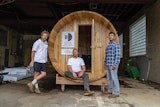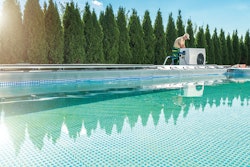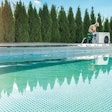Wanted: A Few Good Players U.S. tired of getting beat
U.S. tired of getting beat by world at odd sport
The annals of sport are filled with heartwarming stories of undersized and overmatched teams using sheer determination and heart to overcome their opponents. Who can forget the ragtag assemblage of college kids and rink rats that defeated the mighty Russian hockey team in the 1980 Winter Olympics. Or Joe Namath and his upstart New York Jets' stunning upset of the Baltimore Colts in the third Super Bowl.
In 1999 at the World Underwater Rugby Championships, a team of Americans were set to make history themselves by playing Davids to the world's Goliaths. With images of the cheering legions of fans, tickertape parades and lucrative endorsements that would surely follow when they crushed the fearsome Swedes, the team took to the water. After a great deal of splashing and thrashing, the team emerged from the pool, dripping and exhausted, where they were presented with the Sportsmanship Award (that's not a good thing).
"We didn't do so well," admits Arthur Davies, national director for the Underwater Rugby Society of America. "Other teams had government support and trainers and all that. We're just a bunch of guys that play. Hopefully in 2003 we'll have a bigger talent pool to draw from."
Davies is hoping to get the word out about the sport to encourage wider participation and increase competitiveness. It really isn't that hard to describe or understand, assuming you know something about rugby, but Americans know little about the land version of the sport much less the underwater version. Suffice to say the basic concept is to put the ball into a goal. It's kind of like soccer that way, only you use your hands instead of your feet. It's also a bit like football, only without huddles or John Madden.
The playing area is 30 to 40 feet wide and 40 to 60 feet long, with goals located 12 to 16 feet deep. The ball is filled with a salt solution to give it a negative buoyancy so it will sink. A team is made up of six players wearing masks, fins and snorkels. Choking, hitting and holding a player without the ball are forbidden, as is pulling on swimsuits. Otherwise, pretty much anything goes. To learn more about underwater rugby, or other underwater sports you didn't know existed, such as hockey or football, visit underwater-society.org.
Inside or Out
inventive system makes portable spas mobile Anyone who read AQUA's October issue featuring the 9th Annual Design Awards Competition came across a unique project submitted by Diversatech, Connellsville, Pa.
David Myers, owner of Diversatech, wanted to be able to use his hot tub outdoors when the weather cooperated and indoors when it didn't, so he relied on his experience with the company.
Diversatech manufactures rail systems for furnace cars used in steel mills. The furnace car follows this railing system into the furnace and the furnace doors close behind.
This same concept is used with his home hot tub.
A four-button, low-voltage switch control pad was installed on the hot tub to open and close the shelter door and move the tub forward or backward. No detail was missed, including safety. When the tub is in motion, a beeper sounds to alert anyone close by to move out of the way. It is also equipped with brakes. For homes that have small children, a safety lock switch is available for parents. Myers hopes the idea will take off nationwide.
"We're going to attempt to franchise across the country in different regions (regions with a similar climate to Pennsylvania's), says Myers. "During winter evenings, you will be able to have the privacy of your house, or drive it outside and enjoy the cool air with the warmth of the hot tub underneath the stars."
Spa Sanitizer Heads for Open Water
technology used in tubs tested aboard oil tankers to combat bacteria
Scientists working to find ways to kill "hitchhiking" organisms on oil tankers are now testing a technology already used in sterilizing hot tubs.
Recent experiments aboard the oil tanker Tonsina, just off the coast of Anchorage, Alaska, could provide a major breakthrough in combating unmanageable ecological problems of today — the transport of bacteria from one coast to another in ballast water.
A prototype system, which mirrors conceptually an ozone hot tub purification system, was developed by Nutech O3, an ozone specialist company, and installed aboard Tonisa last year. The system uses 10,000 volts of electricity to produce four pounds of ozone per hour inside the ship. The ozone is then pumped through stainless-steel piping into the oil tanker's ballast tanks.
This process theoretically kills any plankton, bacteria or viruses in the ballast water.
Ballast water in ships has caused major biological problems around the world, in some cases causing extinction of wildlife. Two million gallons of ballast water is dumped each hour in U.S. ports.
BP began its experiment in the early 1990s after Roger Gale, former president of the company's shipping division, read that ozone is used to purify water in hot tubs.











































